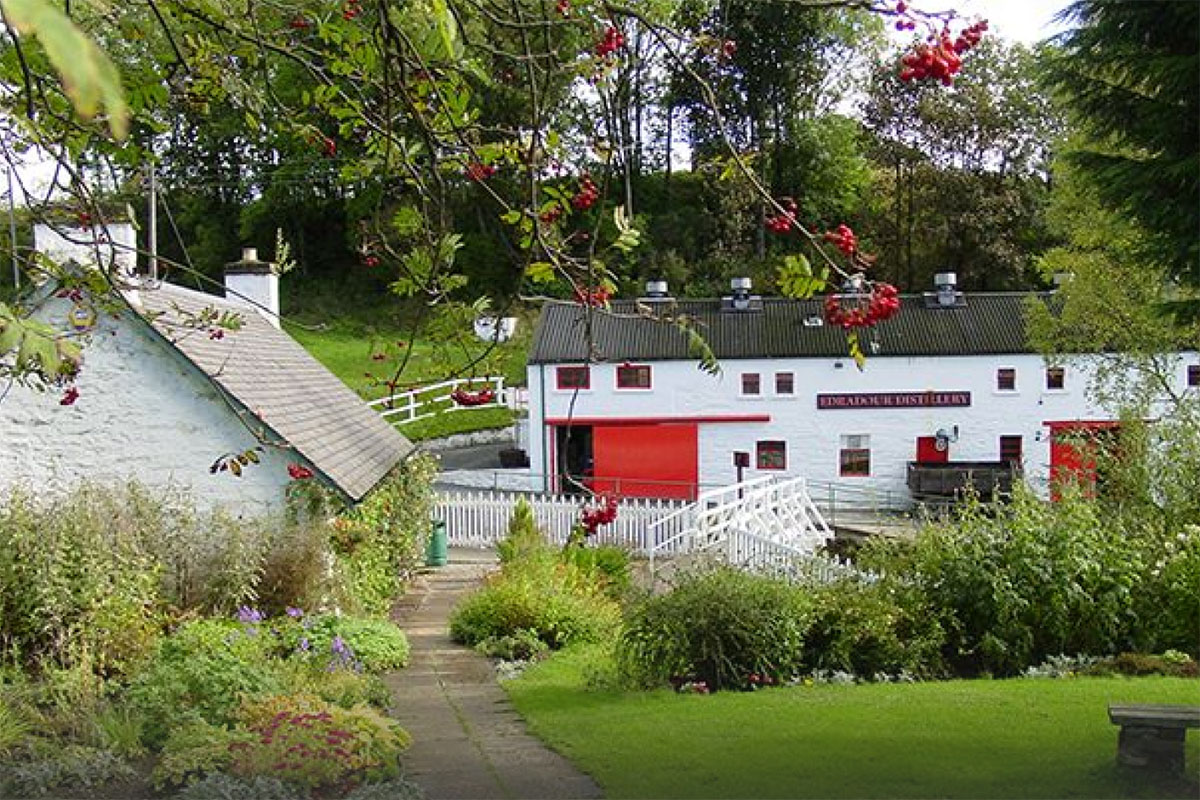Edradour’s story
The name Edradour is derived from the Gaelic ‘edred dobhar‘ meaning ‘the stream of King Edred’. Prior to the craft distilling revolution, Edradour was famously Scotland’s smallest distillery, producing just 95,000 litres of whisky each year. The picturesque farm buildings, its proximity to the town of Pitlochry and the ‘smallest’ tag helped the distillery be one of Scotland’s most visited, attracting approximately 80,000 tourists per year. However, following the Covid pandemic the decision was taken to close the visitor centre indefinitely.
Edradour is housed in its original farm buildings and little changed for much of its history, except the introduction of electricity in 1947 and the conversion of an out barn to a visitor centre during the 1980s. Everything at Edradour was small with all the distilling equipment crammed into one room – the mash tun, two washbacks and a pair of oddly shaped stills. That was until a major extension that almost tripled capacity was commissioned in 2018.
Despite this rapid expansion, all processes use traditional methods with no automation and much of the equipment being made from wood. The stills are also the smallest size permitted for commercial distilling by the Customs & Excise department.
Edradour single malt did not appear until the mid 1980s and current owners, Signatory Vintage, have significantly raised the distillery’s profile and whisky range since taking control in 2002. They regularly experiment with maturation in different casks from numerous origins. This includes Port, Sauternes, Madeira, Burgundy, Chardonnay and Super Tuscan red wine and other spirit casks. They also recreated a traditional smoky style of Highland whisky that died out in the early 20th century. This was first released in 2006 and is called Ballechin (pronounced bal-eek-in).
Edradour’s history
Eight Perthshire farmers set up a co-operative in 1825 with the aim of setting up a legal distillery in the hills behind the town of Pitlochry. The central Highlands was a hotbed of illegal distilling during this time, due to the remoteness of the location and rugged landscape. But following the introduction of The Excise Act in 1823 illegal distillation became more tricky and carried heavy penalties. The co-operative combined their resources and purchased some farm buildings. The location they selected was extremely picturesque and this has allowed Edradour to survive, as a succession of owners have consistently decided to maintain and promote the distillery’s ‘rural charm’.
The original name of the distillery was Glenforres and this changed to Edradour in 1837. Somehow, Edradour survived numerous tough times when other larger distilleries fell by the wayside. In 1933, the distillery was taken over by giant Glasgow blending company, William Whiteley & Co. They changed the name back to Glenforres and used the whisky in several of their premium blends. Campbell Distillers, who would later become a part of the Pernod Ricard group, took over in 1982. They saw the potential for marketing the distillery due to its size, setting and use of traditional distillery methods. It was renamed Edradour and a visitor centre was opened later that year.
The first ever Edradour single malt whisky was released as a 10 years old in 1986. The distillery was sold in 2002 to Andrew Symington, owner of Signatory Vintage, an independent bottling company based in Edinburgh. Signatory Vintage introduced much innovation and quickly expanded the range of single malt whisky available, including numerous quirky bottlings and the aforementioned peated Ballechin.
- How to pronounce Edradour? edra-dow-er
- Country: Scotland
- Region: Highlands
- Founded: 1825
- Current owners: Signatory Vintage
- Production capacity per year: 340,000 litres
- Mash tun: 1.1 ton stainless steel
- Washbacks: 8
- Stills: 4
- Visitor centre: No
Edradour Distillery
Pitlochry
Perthshire
PH16 5JP
tel – +44(0)1796 472 095
www.edradour.com
Did you know?
Whisky from Edradour was the main ingredient in a blend called ‘King’s Ransom’ during the 1920s and 1930s. At the time, ‘King’s Ransom’ was the most expensive whisky on the market and is said to have become a favourite of Sir Winston Churchill and Joseph Stalin.
Edradour




